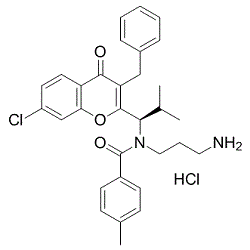| Description: |
SB-743921 is a potent inhibitor of the mitotic kinesin KSP (Eg5), with a Ki of 0.1 nM. |
| Target: |
Eg5:0.1 nM (Ki) |
| In Vivo: |
SB-743921 has good oral bioavailability and pharmacokinetics and induces complete tumor regression in nude mice bearing lung cancer patient xenografts[3]. |
| In Vitro: |
SB-743921 is a potent inhibitor of Eg5, with a Ki of 0.1 nM[1]. SB-743921 (1 nM) potently inhibits colony forming cell (CFC) formation of chronic myeloid leukemia (CML) primary cells, but exhibits slight inhibitory activities on the colony-forming ability of normal bone marrow progenitors. SB-743921 (1, 3 nM) induces apoptosis of CML primary CD34 + cells, and shows slight effect on normal CD34 + cells. SB-743921 (2 nM) in combination with imatinib displays additive anti-proliferative effect in KCL22 and CML CD34 + cells. Furthermore, SB-743921 overcomes imatinib resistance in CML cells. SB-743921 (0.5 nM, 1 nM, 3 nM) inhibits MEK/ERK and AKT signaling in CML cells[2]. |
| Cell Assay: |
K562 and KCL22 cells are seeded in six-well plates at a number of 5 × 105 in 2 mL RPMI-1640 medium supplemented with 10% FBS in a 5% CO2 atmosphere at 37°C, and are treated with control (2% DMSO), 50 nM imatinib, 2 nM SB-743921 and 50 nM imatinib + 2 nM SB-743921, respectively. Cell number and viability are determined every 24 h. Results are plotted for live cells against time to generate a growth curve[2]. |
| Animal Administration: |
The animal experiments are performed with female NMRI nu/nu mice. Tumor fragments are obtained from xenografts in serial passage in nude mice. Mice are randomized to the various groups, and dosing is started when the required number of mice carries a tumor of 50-250 mm3 volume, preferably 80-200 mm3. Vehicle for 1: 10% ethanol, 10% cremophor, 80% D5W (dextrose 5%); vehicle for all other compounds (including SB-743921): 8% DMSO, 2% Tween 80, distilled water (pH 5). All treatments are given intraperitoneally. Vehicle control mice (group 1) are treated with 10 mL/kg vehicle on days 0, 3, 6, 8, 10, 13, 20, 22, 24, 29, 31, 34, 36, 38, 48, 51, 55, 58, 62, 65, and 69[3]. |
| References: |
[1]. Jeffrey R. Jackson, et al. A second generation KSP inhibitor, SB-743921, is a highly potent and active therapeutic in preclinical models of cancer. First AACR International Conference on Molecular Diagnostics in Cancer Therapeutic Development, Sep 12-15, 2006.
[2]. Yin Y, et al. Kinesin spindle protein inhibitor SB743921 induces mitotic arrest and apoptosis and overcomes imatinib resistance of chronic myeloid leukemia cells. Leuk Lymphoma. 2015 Jun;56(6):1813-20.
[3]. Good JA, et al. Optimized S-trityl-L-cysteine-based inhibitors of kinesin spindle protein with potent in vivo antitumor activity in lung cancer xenograft models. J Med Chem. 2013 Mar 14;56(5):1878-93. |






















